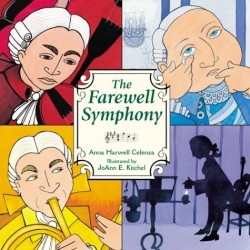The Farewell Symphony
It is November of 1772 in Esterhaza, the summer palace of Prince Nicholas. During the performance of a new symphony by court composer Franz Joseph Haydn, the baffled Prince watches as, one by one, musicians stop playing, snuff their candles, and leave the stage. The story behind this famous piece is the fascinating basis for Celenza’s The Farewell Symphony. Using archival documents from various European libraries, Celenza has provided an inside look at court life and the creative process of a well loved composer.
Papa Haydn, as he was known, was responsible not just for composing operas, symphonies, dances, and sacred music, but also for managing all the instruments and the musicians of the court orchestra. When the musicians are called to the summer palace, the pace of performances at first keeps them too busy to be homesick. Summer drags into November and they begin to miss their families. They plead with Haydn to convince the Prince to return to Austria. He answers their plea with The Farewell Symphony, allowing each movement to relate the plight of the orchestra to the Prince.
Although the descriptions of how the Prince reacted to each movement are fictionalized, the resulting immediate return to Austria is fact. Children and adults are often interested in the story behind great works of art, and this one is doubly enhanced.
First, the watercolor and ink illustrations by Kitchel are three-quarter page spreads, with additional border designs on many pages. They have a stained-glass quality, and adeptly depict the wigs and ruffles of the time as well as the emotions of the music. Secondly, the book comes with a compact disc of not only The Farewell Symphony (no. 45), but also The Hornsignal Symphony. How delightful to be able to read this story and listen to the music as the same time. There is additional information about the distinctiveness of the eighteenth century symphony and an author’s note.
Reviewed by
Leigh Forrest
Disclosure: This article is not an endorsement, but a review. The publisher of this book provided free copies of the book to have their book reviewed by a professional reviewer. No fee was paid by the publisher for this review. Foreword Reviews only recommends books that we love. Foreword Magazine, Inc. is disclosing this in accordance with the Federal Trade Commission’s 16 CFR, Part 255.

